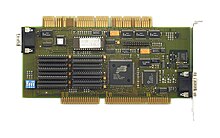Extended ISA
The Extended Industry Standard Architecture (in practice almost always called EISA ) is a standard bus that extends the ISA bus to 32 bits . It also adds the ability to share the bus between multiple CPUs . The support for bus mastering has also been further improved, so that 4 GB of memory are now available. In contrast to the MCA , EISA can use older cards from the XT bus and from the ISA bus . This is made possible by a two-tier design of the slot and a locking notch (prevents the older cards from touching the newly added contacts). The configuration of the expansion cards had to be done manually in the BIOS, an automatic configuration as with PCI did not yet exist.
The EISA standard was initiated by Compaq in the late 1980s - as an antagonist to IBM's MCA in their PS / 2 series. Although EISA was technically inferior to MCA, its backward compatibility made it more popular.
See also
- Industry Standard Architecture (ISA)
- Micro Channel Architecture (MCA)
- VESA Local Bus (VLB)
- Peripheral Component Interconnect (PCI)
- XT bus architecture
Technical specifications
| Bus width | 32 bit |
| insertable cards | 16 bit ISA, XT bus , 32 bit EISA |
| Pins | 98 + 100 inlay |
| Pitch | 2.54mm / 1.27mm |
| Operating voltages | +5 V, −5 V, +12 V, −12 V |
| Bus cycle | 8.33 MHz |
| theoretical data throughput (32 bit) | approx. 32 MB / s |
| usable data throughput (32 bit) | approx. 20 Mbytes / s |





